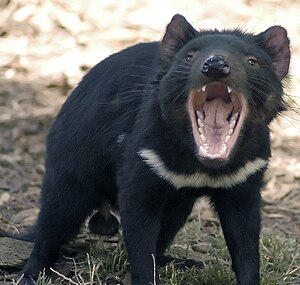Predator
| Predator | ||||||||||||
|---|---|---|---|---|---|---|---|---|---|---|---|---|

Tasmanian devil ( Sarcophilus harrisi ) |
||||||||||||
| Systematics | ||||||||||||
|
||||||||||||
| Scientific name | ||||||||||||
| Dasyuridae | ||||||||||||
| Goldfuss , 1820 |
The Raubbeutler (Dasyuridae) are a family within the marsupial order of the Predator-like (Dasyuromorphia). This group, which includes around 75 species, includes, among other things, bag-marten , bag-devil and bag-mice .
distribution
Predatory predators are found in Australia , New Guinea , Tasmania and other offshore islands.
description
Predatory baggers are basically similar in physique, but there are significant differences in size. Flat-headed pouch mice and Ningauis are sometimes only around 10 centimeters long and weigh 5 grams, the marsupial devil, the largest species, is over a meter long and weighs over 10 kilograms. The front and rear legs are approximately the same length, on the front legs they have five, on the hind legs four or five toes, these are separate (in contrast to the Diprotodontia ). In some tree-dwelling species, the big toe is opposable . The 42 to 46 teeth are designed for the consumption of meat. Predator teeth have many small incisors , large canines and molars with sharp chewing surfaces.
Way of life
Predator animals are predominantly nocturnal, during the day they crawl into earthworks, hollow tree trunks or in nests made of grass, twigs and leaves. Most of the species are ground dwellers, although there are also some species of bag mice that predominantly live in trees. They are considered skilled hunters with sharp senses. Predatory baggers are mainly carnivores. Depending on their size, the smaller ones feed on insects and other arthropods , the larger ones also on vertebrates , and sometimes they can overwhelm animals that are the same size or larger than themselves. Some species also consume nectar or carrion.
Reproduction
Although predatory pouches are marsupials , not all species have a pouch. Sometimes the young animals are also housed in belly folds, in other species a pouch only develops during pregnancy. Females usually have six to eight teats and are characterized by a relatively long gestation period for marsupials. A peculiarity of some genera such as the broad-footed pouch mice or brushtail pouches is that almost all males die at the same time after the first mating, i.e. often only live ten to eleven months. The life expectancy of the other species is also low; many pouch mice do not get older than two to three years.
threat
Many species have lost parts of their original habitat due to human influences - especially since the arrival of the Europeans. These influences are, on the one hand, the colonization and conversion of steppes and forests into arable land and pastures, and on the other hand, the introduction of predatory animals that did not originally occur in Australia, such as dingoes , cats or foxes . Six predator species are classified as endangered by the IUCN .
Genera and species



The larger and better known species include the marsupial devil and the bag marten . Many smaller genera and species are grouped under the term " bag mice ", although this term does not represent a biological classification, as some species are more closely related to the large predatory mammals than to each other.
The Predator are divided into the following genera:
-
Subfamily Dasyurinae
-
Tribe Dasyurini
- Dasycercus , two species
- Red broad-footed pouch mouse ( Dasykaluta rosamondae )
- Double- Combed Pouch Mouse or Kowari ( Dasyuroides byrnei )
- Bag marten ( Dasyurus ), six species
- Striped marten ( Myoictis ), four species
- Spitzhörnchenbeutler ( Neophascogale lorentzi )
- Speckled pouch mouse ( Parantechinus apicalis )
- Striped sac mice ( Phascolosorex ), two species
- Fat-tailed pouch mice ( Pseudantechinus ), six species
- Tasmanian devil ( Sarcophilus harrisii )
-
Phascogalini tribe
- Broad-footed bag mice ( Antechinus ), 15 species
- Brushtail Butler ( Phascogale ), three species
- New Guinea bag mice ( Murexia ), a total of five species
-
Tribe Dasyurini
-
Subfamily Sminthopsinae
-
Tribus Sminthopsini
- Springbag mouse or Kultarr ( Antechinomys laniger )
- Ningauis ( Ningaui ), three types
- Narrow-foot pouch mice ( Sminthopsis ), around twenty species
-
Tribe Planigalini
- Flat head pouch mice ( Planigale ), five species
-
Tribus Sminthopsini
The internal system is illustrated by the following cladogram , which also shows that the genus of the narrow-foot bag mice ( Sminthopsis ) is not monophyletic .
| Dasyuromorphia |
|
||||||||||||||||||||||||||||||||||||||||||||||||||||||||||||||||||||||||||||||||||||||||||||||||||||||||||||||||||||||||
|
|
literature
- Ronald M. Nowak: Walker's Mammals of the World . Johns Hopkins University Press, Baltimore 1999. ISBN 0-8018-5789-9
- DE Wilson, DM Reeder: Mammal Species of the World . Johns Hopkins University Press, Baltimore 2005. ISBN 0-8018-8221-4
- Marcel Cardillo, Olaf RP Bininda-Emonds, Elizabeth Boakes, Andy Purvis: A species-level phylogenetic supertree of marsupials . In: Journal of Zoology . tape 264 , no. 1 , 2004, p. 11-31 , doi : 10.1017 / S0952836904005539 .
- PA Wooley: The species of Dasycercus Peters, 1875 (Marsupialia: Dasyuridae) . Memoirs of Museum Victoria 62 (2): 213-221 (2005).
supporting documents
- ↑ Michael Westerman, Carey Krajewski, Benjamin P. Kear, Lucy Meehan, Robert W. Meredith, Christopher A. Emerling, Mark S. Springer: Phylogenetic relationships of dasyuromorphian marsupials revisited. Zoological Journal of the Linnean Society, Volume 176, Issue 3, March 2016, pp. 686-701, doi: 10.1111 / zoj.12323